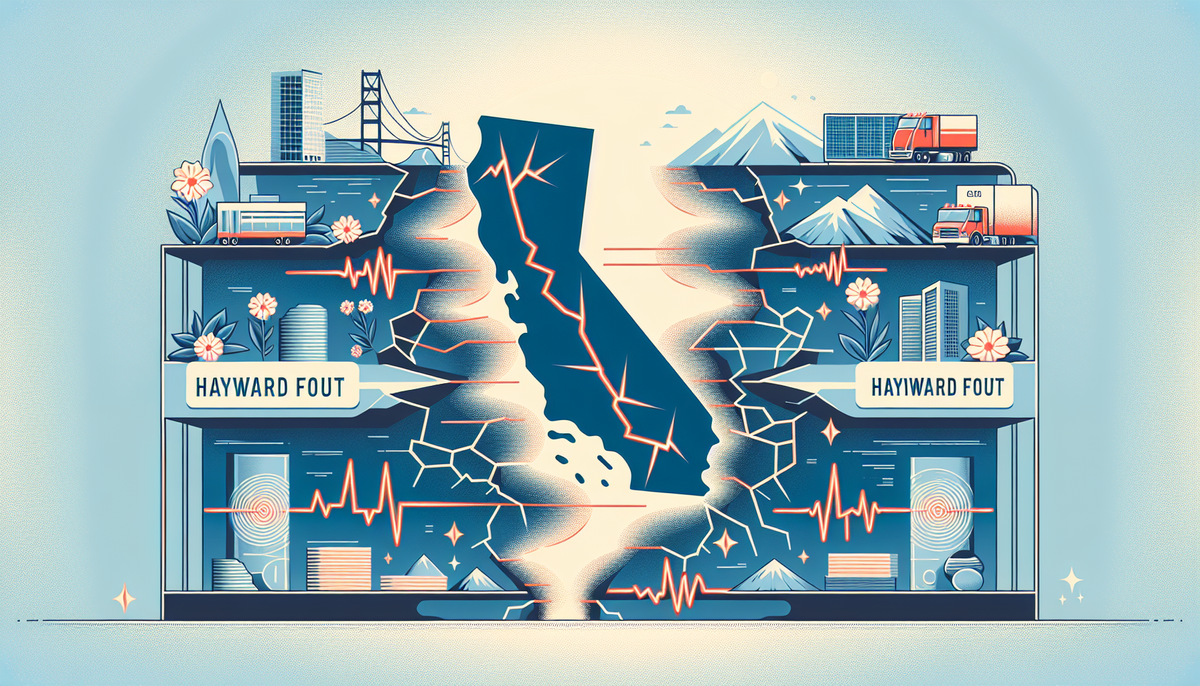California Seismic Activity: Is the Big One Near?

Overview of California's Seismic Activity
California has long been synonymous with seismic activity. With its intricate network of fault lines, including the infamous Hayward and San Andreas faults, the state remains under constant scrutiny by seismologists and emergency response teams. Recent tremors have added to concerns that the region could be on the brink of a major seismic event—often referred to as the 'Big One.' In this article, we delve into the latest earthquake activity, explore historical data, and examine scientific research that outlines the risks and necessary precautions for residents and authorities.
Recent Tremors Along the Fault Lines
Over the past few days, several earthquakes have been recorded along the Hayward fault and near the San Andreas fault. These events have varied in magnitude, drawing immediate attention from the United States Geological Survey (USGS). Among the reported quakes, a series of events centered in the Hayward region have alarmed local communities, leading to fears that these may be precursors to a larger seismic event.
- A 3.7 magnitude earthquake was reported in Hayward, prompting widespread concern.
- Multiple tremors in rapid succession were detected, with magnitudes ranging from 2.7 to 3.7.
- Additional events near the San Andreas fault, spanning over 800 miles, signal that the entire tectonic system is actively moving.
These recent tremors, though moderate on the Richter scale, serve as crucial data points for scientists tracking seismic patterns in a region known to experience powerful earthquakes every few decades.
Historical Significance of the Hayward Fault
The Hayward Fault is one of California's most studied seismic features. Historically, it has produced significant quakes, such as the massive 6.8 magnitude event recorded in 1868. Although modern engineering and building codes have improved safety standards considerably, understanding the fault's past behavior remains key to predicting future risks.
Historical records indicate the following:
- 1868 Event: A major earthquake known to have caused substantial damage and loss of life.
- Periodic Activity: The fault has shown a cyclical pattern, with major earthquakes occurring roughly every 140 years.
- Recent Precursors: Smaller tremors in recent decades have suggested an increasing build-up of tectonic stress.
The significant gap since the last catastrophic event has led many experts to warn that the fault may be overdue for another major release of energy.
Scientific Monitoring and Latest Research
Modern seismology utilizes a range of technologies to track the inner workings of the Earth's crust. In California, networks of sensors and early-warning systems are strategically positioned to monitor even the smallest shifts in the tectonic plates. The data collected by these sensors is analyzed by both governmental and academic institutions.
Key points from recent studies include:
- USGS Analysis: The United States Geological Survey has been pivotal in providing real-time earthquake data, helping communities understand the risks and scale of seismic activity.
- Academic Research: Institutions such as the University of California, Berkeley are at the forefront of predicting seismic events. Researchers have noted that the frequency and clustering of smaller tremors can be indicative of stress accumulation along fault lines.
- Tectonic Movements: Studies published in respected journals, such as Geophysical Research Letters, have pointed out that even deep underwater faults within the Pacific plate contribute to the overall dynamics of the region.
Advanced computer modeling and historical data correlation have provided experts with a better understanding of when a significant quake might occur. Despite ongoing research, predicting the exact timing of a major earthquake remains a complex challenge.
What Experts Are Saying
Seismologists and geologists have weighed in on the recent activity along the Hayward and San Andreas faults, offering perspectives that range from cautious optimism to urgent alarm. While small quakes occur frequently, the pattern of these events in recent times has led experts to question whether the region is nearing a critical state.
- Dr. Angela Rivera, Seismologist: 'The clustering of moderate earthquakes in our monitoring data is concerning and suggests that stress is building along key fault lines.'
- Professor Mark Jensen, Geologist: 'Historical records and current geophysical measurements indicate that the Hayward fault is nearing a break point. The potential for a major quake in the next 30 years is very real.' (Source: University of California, Berkeley)
- USGS Spokesperson: 'While no one can predict earthquakes with absolute certainty, the data currently available strongly urges preparedness and continual monitoring.'
Such voices from the scientific community underscore the importance of innovative research and community readiness in the face of natural disasters.
Understanding Tectonic Forces and Plate Movements
California's landscape is continuously shaped by the movement of tectonic plates. The Pacific Plate, which lies beneath the Pacific Ocean, interacts dynamically with the North American Plate along fault lines that run through the state. This movement results in regular seismic activity, some of which are imperceptible to humans, while others can significantly alter the landscape.
Implications of these tectonic movements include:
- Fault Line Interactions: The San Andreas and Hayward faults are part of a larger network where stress and strain are constantly being redistributed.
- Energy Build-up: The gradual accumulation of tectonic energy over time can result in sudden large releases, leading to high-magnitude earthquakes.
- Real-World Impact: Beyond the scientific data, these movements affect everyday life—from structural integrity of buildings to the reliability of transportation infrastructure.
By using advanced sensors and sophisticated modeling software, experts are now able to map these fault interactions with an unprecedented level of detail. This ongoing research not only aids in short-term earthquake prediction but also helps inform long-term urban planning and public safety strategies.
Preparedness and Safety Measures
In the face of continual seismic activity, being prepared is crucial. State and local governments, in partnership with scientific agencies, have implemented various measures to improve resilience and response in the event of a major quake.
Residents are encouraged to take the following precautions:
- Emergency Kits: Ensure that your home is stocked with essentials such as water, non-perishable food, first aid supplies, and other emergency items.
- Structural Inspections: If you live in an area prone to earthquake damage, have your home inspected and retrofitted to withstand shaking.
- Family Preparedness Plans: Develop clear communication and meeting plans with family members in the event of an emergency.
- Stay Informed: Follow updates from the USGS and local authorities regarding seismic activity and safety advisories.
Local governments also engage in regular earthquake drills and community outreach programs to educate residents about the risks and proper responses during an earthquake. Moreover, investment in early-warning systems has improved response times, giving those in affected areas valuable seconds to seek safety before violent shaking begins.
Impact on Infrastructure and Recovery Plans
The potential damage from a major earthquake on California’s densely populated urban areas cannot be overstated. Cities like San Francisco, Oakland, and Fremont would face significant challenges in the aftermath of a large seismic event. Infrastructure—from roads and bridges to hospitals and schools—needs to be resilient to sustain the shock and facilitate rapid recovery.
Key aspects of recovery and mitigation include:
- Building Codes: Modern building codes are designed to ensure that structures can endure significant shaking. Continuous improvements reflect lessons learned from past events.
- Urban Planning: Authorities are incorporating seismic risk assessments into urban development plans to minimize risk in new constructions.
- Insurance and Relief Funds: Programs aimed at assisting affected populations help in rapid recovery and rebuilding efforts after catastrophic events.
The economic implications of a major quake are enormous. Experts estimate that a significant seismic event could result in billions of dollars in damage, affect thousands of lives, and necessitate decades of rebuilding. However, preemptive investments in safety and infrastructure can mitigate these effects significantly.
Looking Ahead: Research and Future Steps
Although predicting the exact moment of a major earthquake remains an elusive goal, continued investments in research are vital. The combined efforts of government agencies, academic institutions, and private research organizations are paving the way for more reliable forecasting methods.
Future research priorities include:
- Enhanced Sensor Networks: Expanding the number of monitoring stations to cover more areas with high seismic risk.
- Data Integration: Leveraging machine learning and big data to identify patterns that could serve as early-warning indicators.
- Collaborative Research: International collaborations to share the latest findings and improve global earthquake prediction models.
These initiatives are not only crucial for California but are also a model for other regions grappling with similar geological challenges. As technology evolves, the prospect of providing earlier and more accurate warnings becomes increasingly attainable.
Concluding Remarks
The recent seismic activities in California are a stark reminder of the earth's dynamic and often unpredictable nature. As scientists continue to interpret the data from the Hayward and San Andreas faults, communities are urged to remain vigilant and prepared for future events. Whether you are a resident, a researcher, or simply a science enthusiast, the developments in seismic research and preparedness strategies offer a compelling glimpse into how human ingenuity strives to coexist with natural hazards.
For further details, please refer to authoritative sources such as the United States Geological Survey (USGS) and recent publications in peer-reviewed journals. Staying informed and prepared is our best defense against the unpredictable might of nature.
As California navigates these challenges, both the government's response strategies and the scientific community's ongoing research will be critical in mitigating risks and safeguarding millions of lives. With continued vigilance and technological advancements, we can hope to better understand, predict, and ultimately withstand the forces that shape our world.



Comments ()